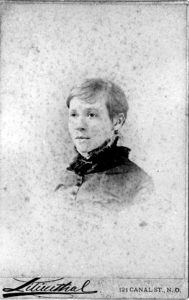Theodore Lilienthal
Part of the first generation of photographers in New Orleans, Theodore Lilienthal was city's most successful nineteenth-century photographic entrepreneur.

Courtesy of The Historic New Orleans Collection
Eliza Jane Nicholson. Lilienthal, Theodore (Photographer)
Part of the first generation of photographers in New Orleans, Theodore Lilienthal was city’s most successful nineteenth-century photographic entrepreneur. At the height of his commercial success, from 1875 to 1885, he operated one of the largest studios in the South, and was recognized as a pioneer of new photographic processes. His work as a portraitist and view maker was unsurpassed in the Civil War and Reconstruction eras, and his most important work, a portfolio of views of New Orleans executed for the Paris Exposition of 1867, remains one of the supreme achievements of nineteenth century urban photography in America.
Born in Frankfurt-on-the-Oder, Prussia, in 1829, Lilienthal emigrated to New Orleans in 1853. Within a year of arriving in the city he was practicing as a daguerreian. (The daguerreotype was an early form of photography using a light-sensitive silver-coated metallic plate.) Until the outbreak of the Civil War, he partnered with German-born photographers and painters, his studio trade anchored in the large local German immigrant community. During the war he established a successful practice in military carte de visite, a type of small photograph portraiture. Initially most of his business came from the thousands of Confederate troops mustered in the city; later the Union occupiers became his primary customers.
He was probably the first local photographer to invest in a darkroom wagon, which he began operating out of his Poydras Street studio in 1865. The traveling darkroom gave him access to the large market in outdoor views, and from the late 1860s to the end of his career he was among the largest publishers of stereoviews of New Orleans. A federal commission in late 1865 to photograph military facilities in the city, and a prize-winning exhibition at the 1866 Mechanics and Agricultural Fair, established his reputation locally as an urban photographer.
Lilienthal was now in position for the most significant commission of his career. In early 1867, the New Orleans city council hired him to prepare an exhibit that would appear at the Paris World Exposition. The exhibit, a portfolio of views of the major architectural and commercial features of the city, would also be presented to the Emperor Napoleon III of France. Entitled La Nouvelle Orleans et ses environs, Lilienthal’s work comprised 150 large (11 inch by 15 inch) albumen photographs. In the economically depressed conditions of post-Civil War New Orleans, city boosters conceived of the photographic portfolio as a publicity tool to revitalize overseas trade and attract European immigration and investment. Toward this end, Lilienthal presented a vigorous port city of commerce and culture undiminished by war. This Reconstruction campaign is the first known use of photography for municipally sponsored civic boosterism in America.
Several years after this work, Lilienthal completed another photographic portrait of the city: more than 100 street and building views for the New Orleans publisher Edwin Jewell. The photographs were engraved in wood by John William Orr of New York to illustrate the city’s first commercial booster book, Jewell’s Crescent City Illustrated. Published in 1873, the book was intended to promote the city to northern investors.
In 1875 Lilienthal opened an upmarket studio on the city’s main retail street, Canal. The new studio, the largest in the city, attracted a socially elite clientele and signaled Lilienthal’s recognition locally as well as nationally, particularly in innovative studio practice. Always quick to secure the “latest success in photography,” as his advertisements promised, Lilienthal offered customers a succession of Lambertypes, Platinotypes, Artotypes, and other newly patented photographic processes. He was particularly recognized for his work in a carbon-patent process, called the Lambertype. This process offered a solution to the vexing problem of fading, common with silver albumen prints. Anthony’s Photographic Bulletin reported in 1877 that Lilienthal was among the first photographers to “practically abandon silver printing” for carbon. Mastering the carbon process in the New Orleans market was profitable. “No man in the United States has made such a wonderful success with the carbon process as Lilienthal,” the St. Louis Practical Photographer reported. An 1883 patent infringement suit that Lilienthal filed against competitor William Washburn—called the “battle of the photographers” by the local press—revealed the extent of his professional investment in the process.
His costly studio operation and overinvestment in new materials and processes put Lilienthal at financial risk. The patent case and another lawsuit brought by his adopted son, Louis, also a photographer, led to his bankruptcy in 1887. He reestablished his practice through various partnerships, but in 1890 his studio, including his vast stock of negatives, was destroyed by fire. Although he continued to work until 1894, he was now suffering from Bright’s disease, an affliction often linked to exposure to darkroom chemistry. He died in November 25, 1894.
